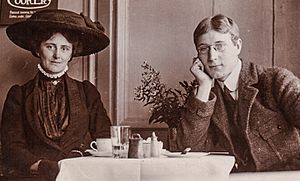Sir Francis Knowles, 5th Baronet facts for kids
Sir Francis Howe Seymour Knowles, 5th Baronet (born January 13, 1886 – died April 4, 1953) was an English anthropologist. He was the fifth person to hold the special title of Knowles Baronet.
Sir Francis first studied Law at Oriel College, Oxford. But he soon became interested in anthropology, which is the study of humans, their cultures, and history. In 1908, he was one of the first students to earn a special Diploma in Anthropology. He studied at the Pitt Rivers Museum at Oxford University. Later, he also earned a B.Sc. degree there.
Contents
Early Life and Family History
Sir Francis came from a family with a long history. His great-great-grandfather, Sir Charles Knowles, was an admiral in the navy. He was given the baronet title in 1765 for his naval service. A baronet is a special title of honor, similar to a knight, that can be passed down in a family.
Many men in his family were named Charles and became admirals. But Sir Francis, like his grandfather, also named Francis, chose a science career. His own son, Francis, would also become a famous scientist. Sir Francis's father, Vice Admiral Sir Charles Knowles, 4th Baronet, met his mother, Mary Ellen Thomson, in Canada. Her grandfather was a well-known Canadian leader. This connection might have made Sir Francis want to work in Canada later on.
Studying Ancient Humans
In 1909, Sir Francis got a job at Oxford University. He became an assistant to Professor Arthur Thomson, who studied human anatomy. Sir Francis's job was to teach and research physical anthropology. This was the first job of its kind at Oxford.
For the next three years, he carefully studied and recorded many collections of skulls. He also worked with another scientist, Sir Arthur Keith. They wrote reports about old human bones, including ancient teeth found in a cave on Jersey island. He also looked at the bones of a famous ancient skeleton called the Red Lady of Paviland in 1913.
Working in Canada
From 1912 to 1919, Sir Francis worked as a Physical Anthropologist for the Canadian government. He traveled to Canada to study different groups of people. In 1912, he began working with the Iroquois people on the Six Nations Reserve in Ontario. He also visited the Seneca people in New York State.
He measured their faces and bodies, but he also took many photographs. His pictures of the Iroquois people were very special. They showed a deep understanding of the people, more than just scientific measurements. Sir Francis was also a trained sculptor. He had an artist's eye, which helped him take such great photos. He even loved making clay busts, which are sculptures of people's heads and shoulders.
He wrote two important books about his work in Canada. One was about the skulls of the Eskimo people. The other was about the Iroquois people he studied. Sadly, he caught typhoid fever in Canada. This illness made him too sick to continue his work as a physical anthropologist. So, he returned to England.
Becoming a Stone Tool Expert
After returning to England, Sir Francis settled in Oxford. He started to study how people from the Stone Age made their tools and weapons. He spent a lot of time at the Pitt Rivers Museum. He learned how to make stone tools himself, which is called experimental archaeology.
He helped set up special displays at the Pitt Rivers Museum. These displays showed how stone tools were made, from ancient times to the people who made gun-flints in Brandon. He even drew the pictures for these displays himself. His book, The Stone-Worker’s Progress (published in 1953), shared all his research. He also wrote papers, like one about making a flint arrowhead.
Even though he wasn't rich, Sir Francis worked at the Pitt Rivers Museum for free until he died. This was because of his ongoing health problems from typhoid. He had started collecting stone tools in 1904. Over the years, he gave hundreds of stone tools, gun-flints, and other items to the museum. He also donated objects from different cultures, like boomerangs. After his son died in 1974, most of his remaining collection also went to the museum.
Sir Francis also helped the museum by writing detailed notes about the objects. His notes were known for being very good. He also spent time teaching students until at least 1949.
The museum's curator, T. K. Penniman, wrote about Sir Francis after he passed away. He said that Sir Francis was very generous with his time and knowledge. He inspired his students to work hard. Both Sir Francis and Lady Knowles cared deeply about the museum and its staff. Penniman wrote that Sir Francis's work was based on careful observation and experiments. He believed Sir Francis's work would last and that his example would live on through those he taught.
His Family and Legacy
Sir Francis married Kathleen Constance Averina Lennon. He became the baronet after his father passed away in 1917. Sir Francis died in Oxford on April 4, 1953. He is buried in Wolvercote Cemetery there. His only son, Francis Gerald William Knowles, took over the baronet title after him.
See also
- Knowles Baronets


